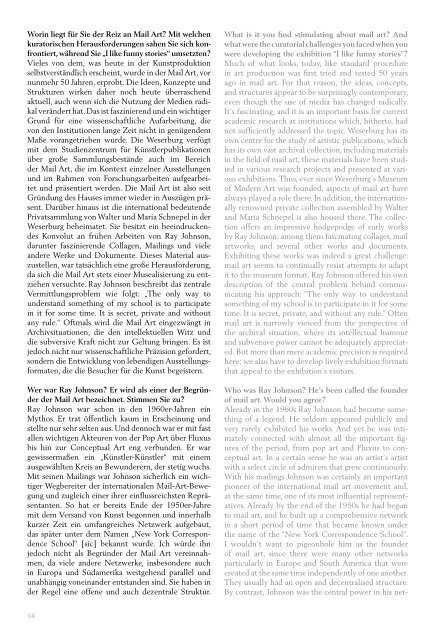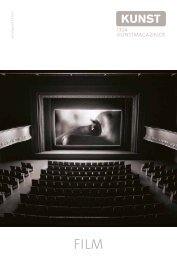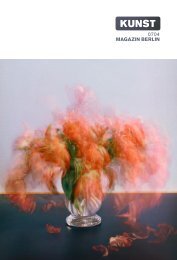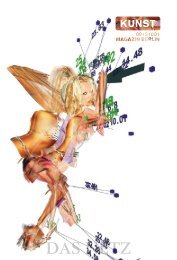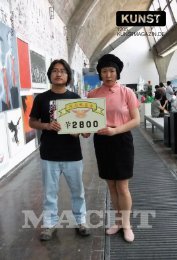Download als .pdf - KUNST Magazin
Download als .pdf - KUNST Magazin
Download als .pdf - KUNST Magazin
Erfolgreiche ePaper selbst erstellen
Machen Sie aus Ihren PDF Publikationen ein blätterbares Flipbook mit unserer einzigartigen Google optimierten e-Paper Software.
Worin liegt für Sie der Reiz an Mail Art? Mit welchen<br />
kuratorischen Herausforderungen sahen Sie sich konfrontiert,<br />
während Sie „I like funny stories“ umsetzten?<br />
Vieles von dem, was heute in der Kunstproduktion<br />
selbstverständlich erscheint, wurde in der Mail Art, vor<br />
nunmehr 50 Jahren, erprobt. Die Ideen, Konzepte und<br />
Strukturen wirken daher noch heute überraschend<br />
aktuell, auch wenn sich die Nutzung der Medien radikal<br />
verändert hat. Das ist faszinierend und ein wichtiger<br />
Grund für eine wissenschaftliche Aufarbeitung, die<br />
von den Institutionen lange Zeit nicht in genügendem<br />
Maße vorangetrieben wurde. Die Weserburg verfügt<br />
mit dem Studienzentrum für Künstlerpublikationen<br />
über große Sammlungsbestände auch im Bereich<br />
der Mail Art, die im Kontext einzelner Ausstellungen<br />
und im Rahmen von Forschungsarbeiten aufgearbeitet<br />
und präsentiert werden. Die Mail Art ist <strong>als</strong>o seit<br />
Gründung des Hauses immer wieder in Auszügen präsent.<br />
Darüber hinaus ist die international bedeutende<br />
Privatsammlung von Walter und Maria Schnepel in der<br />
Weserburg beheimatet. Sie besitzt ein beeindruckendes<br />
Konvolut an frühen Arbeiten von Ray Johnson,<br />
darunter faszinierende Collagen, Mailings und viele<br />
andere Werke und Dokumente. Dieses Material auszustellen,<br />
war tatsächlich eine große Herausforderung,<br />
da sich die Mail Art stets einer Musealisierung zu entziehen<br />
versuchte. Ray Johnson beschreibt das zentrale<br />
Vermittlungsproblem wie folgt: „The only way to<br />
understand something of my school is to participate<br />
in it for some time. It is secret, private and without<br />
any rule.“ Oftm<strong>als</strong> wird die Mail Art eingezwängt in<br />
Archivsituationen, die den intellektuellen Witz und<br />
die subversive Kraft nicht zur Geltung bringen. Es ist<br />
jedoch nicht nur wissenschaftliche Präzision gefordert,<br />
sondern die Entwicklung von lebendigen Ausstellungsformaten,<br />
die die Besucher für die Kunst begeistern.<br />
Wer war Ray Johnson? Er wird <strong>als</strong> einer der Begründer<br />
der Mail Art bezeichnet. Stimmen Sie zu?<br />
Ray Johnson war schon in den 1960er-Jahren ein<br />
Mythos. Er trat öffentlich kaum in Erscheinung und<br />
stellte nur sehr selten aus. Und dennoch war er mit fast<br />
allen wichtigen Akteuren von der Pop Art über Fluxus<br />
bis hin zur Conceptual Art eng verbunden. Er war<br />
gewissermaßen ein „Künstler-Künstler“ mit einem<br />
ausgewählten Kreis an Bewunderern, der stetig wuchs.<br />
Mit seinen Mailings war Johnson sicherlich ein wichtiger<br />
Wegbereiter der internationalen Mail-Art-Bewegung<br />
und zugleich einer ihrer einflussreichsten Repräsentanten.<br />
So hat er bereits Ende der 1950er-Jahre<br />
mit dem Versand von Kunst begonnen und innerhalb<br />
kurzer Zeit ein umfangreiches Netzwerk aufgebaut,<br />
das später unter dem Namen „New York Correspondence<br />
School“ [sic] bekannt wurde. Ich würde ihn<br />
jedoch nicht <strong>als</strong> Begründer der Mail Art vereinnahmen,<br />
da viele andere Netzwerke, insbesondere auch<br />
in Europa und Südamerika weitgehend parallel und<br />
unabhängig voneinander entstanden sind. Sie haben in<br />
der Regel eine offene und auch dezentrale Struktur.<br />
What is it you find stimulating about mail art? And<br />
what were the curatorial challenges you faced when you<br />
were developing the exhibition “I like funny stories”?<br />
Much of what looks, today, like standard procedure<br />
in art production was first tried and tested 50 years<br />
ago in mail art. For that reason, the ideas, concepts,<br />
and structures appear to be surprisingly contemporary,<br />
even though the use of media has changed radically.<br />
It’s fascinating, and it is an important basis for current<br />
academic research at institutions which, hitherto, had<br />
not sufficiently addressed the topic. Weserburg has its<br />
own centre for the study of artistic publications, which<br />
has its own vast archival collection, including materi<strong>als</strong><br />
in the field of mail art; these materi<strong>als</strong> have been studied<br />
in various research projects and presented at various<br />
exhibitions. Thus, ever since Weserburg’s Museum<br />
of Modern Art was founded, aspects of mail art have<br />
always played a role there. In addition, the internationally<br />
renowned private collection assembled by Walter<br />
and Maria Schnepel is <strong>als</strong>o housed there. The collection<br />
offers an impressive hodgepodge of early works<br />
by Ray Johnson, among them fascinating collages, mail<br />
artworks, and several other works and documents.<br />
Exhibiting these works was indeed a great challenge:<br />
mail art seems to continually resist attempts to adapt<br />
it to the museum format. Ray Johnson offered his own<br />
description of the central problem behind communicating<br />
his approach: “The only way to understand<br />
something of my school is to participate in it for some<br />
time. It is secret, private, and without any rule.” Often<br />
mail art is narrowly viewed from the perspective of<br />
the archival situation, where its intellectual humour<br />
and subversive power cannot be adequately appreciated.<br />
But more than mere academic precision is required<br />
here; we <strong>als</strong>o have to develop lively exhibition formats<br />
that appeal to the exhibition’s visitors.<br />
Ray Johnson: o.T. (SAD), 1959, collagierte Postkarte an Dick Higgins,<br />
Slg. Maria und Walter Schnepel, © Ray Johnson Estate, Courtesy Richard L. Feigen & Co.<br />
Johnson blieb dagegen stets das Kraftzentrum seines<br />
Netzwerks, auf das sich letztlich alles bezog. Gleichwohl<br />
hat er <strong>als</strong> Erster konsequent und systematisch<br />
den Postversand künstlerisch umfunktioniert und ist<br />
damit bis heute ein inspirierendes Vorbild.<br />
In Johnsons Werk werden Referenzen zu den Strategien<br />
der Dada-Collagen und dem Element des Zufalls<br />
– einem zentralen Thema von John Cage – deutlich.<br />
In der Tat etablierte Johnson mit seiner Mail Art eine<br />
fließende, sich durch das Versenden und Weiterleiten<br />
permanent verändernde und ergänzende Kunstform.<br />
Durch das sogenannte „on-sending“ gelang es ihm,<br />
seine Künstlerfreunde, Kuratoren und Bekannte in den<br />
künstlerischen Prozess einzubeziehen. Einzelne Sendungen<br />
versah er mit der Bitte „Please send to“ oder<br />
„Please add to and return to“. So entstanden kollaborative<br />
Arbeiten, bei denen der Empfänger zum Versender<br />
und Co-Autor wurde. Der Zufall wurde <strong>als</strong> eine<br />
gestaltgebende Kraft bewusst einkalkuliert. Johnson<br />
bevorzugte dabei stets den Prozess und nicht das<br />
Resul tat. Dies hat sicherlich viel mit John Cages<br />
künstlerischer Auffassung gemein. Es verwundert<br />
nicht, dass sich Ray Johnson und Cage gut kannten<br />
und sogar eine Zeit lang in New York im selben Haus<br />
wohnten.<br />
Ende April 2013 wird die Akademie der Künste eine<br />
Mail-Art-Ausstellung zeigen. Was erwarten Sie?<br />
Von Seth Siegelaub stammt der Satz „Art is to change<br />
what you expect from it“. Dem Gedanken folgend<br />
wünsche ich mir eine anregende Schau, die den<br />
anarchischen Geist der Mail Art in ihrer Vielfalt und<br />
in ihrer permanenten Lust am Experiment erlebbar<br />
macht. Dann gibt sie den notwendigen Raum für<br />
überraschende Entdeckungen, Irritationen und neue<br />
Erkenntnisse.<br />
Who was Ray Johnson? He’s been called the founder<br />
of mail art. Would you agree?<br />
Already in the 1960s Ray Johnson had become something<br />
of a legend. He seldom appeared publicly and<br />
very rarely exhibited his works. And yet he was intimately<br />
connected with almost all the important figures<br />
of the period, from pop art and Fluxus to conceptual<br />
art. In a certain sense he was an artist’s artist<br />
with a select circle of admirers that grew continuously.<br />
With his mailings Johnson was certainly an important<br />
pioneer of the international mail art movement and,<br />
at the same time, one of its most influential representatives.<br />
Already by the end of the 1950s he had begun<br />
to mail art, and he built up a comprehensive network<br />
in a short period of time that became known under<br />
the name of the “New York Correspondence School”.<br />
I wouldn’t want to pigeonhole him as the founder<br />
of mail art, since there were many other networks<br />
particularly in Europe and South America that were<br />
created at the same time independently of one another.<br />
They usually had an open and decentralised structure.<br />
By contrast, Johnson was the central power in his network,<br />
to which all others within it referred. Nevertheless,<br />
he was the first to adapt the mailing service,<br />
consistently and systematically, to his artistic go<strong>als</strong>, and<br />
he thus remains, to this day, an inspirational model.<br />
In Johnson’s works there are obvious references to<br />
the strategies of Dada-collages and to the element of<br />
coincidence—a central theme for John Cage.<br />
With his use of mailing and forwarding in mail art,<br />
Johnson did indeed establish a fluid, permanently<br />
changing and expanding art form. With the practice<br />
of “forwarding” he managed to involve artist-friends,<br />
acquaintances, and curators in the artistic process.<br />
In some of his packages he enclosed requests such<br />
as “Please send to” or “Please add to and return to”.<br />
Thus collaborative works were created; the recipients<br />
became senders and co-authors. Coincidence was<br />
consciously anticipated as a form-giving power. Here<br />
Johnson preferred the process, and not the result. This<br />
certainly has much in common with John Cage’s artistic<br />
conceptions. It’s no wonder that Ray Johnson and<br />
Cage knew each other well and even lived in the same<br />
house in New York for a while.<br />
The Academy of Arts Berlin will be showing an<br />
exhibition of mail art at the end of April. What do you<br />
expect to see there?<br />
Seth Siegelaub once said: “Art is to change what you<br />
expect from it.” Following that thought, I’m hoping<br />
for a stimulating show that allows us to experience<br />
the anarchistic spirit of mail art in all its facets, and<br />
with its permanent desire to experiment. That would<br />
give us the necessary space for surprising discoveries,<br />
provocative stimulation, and new insights.<br />
14 15


